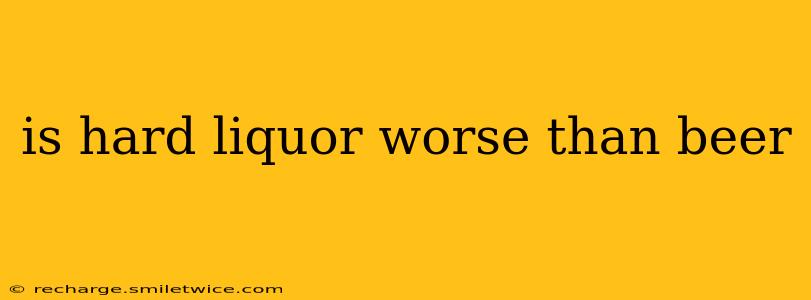The question of whether hard liquor is "worse" than beer isn't easily answered with a simple yes or no. It's more nuanced than that, depending on several factors including the type of alcohol, the amount consumed, and individual factors like body weight and metabolism. Both hard liquor and beer contain alcohol, the primary culprit behind the negative consequences of excessive drinking. However, their differences in alcohol concentration, potential for rapid consumption, and associated cultural contexts contribute to varying levels of risk.
What Makes Hard Liquor Different from Beer?
The core difference lies in the alcohol concentration. Beer typically ranges from 3% to 8% alcohol by volume (ABV), while hard liquor boasts a much higher ABV, generally between 35% and 50% or even higher. This means a smaller quantity of hard liquor contains significantly more pure alcohol than the same volume of beer. This higher concentration directly impacts the speed at which alcohol enters the bloodstream and the intensity of its effects.
How Does Alcohol Concentration Affect the Body?
The higher ABV of hard liquor translates to faster intoxication. Drinking a shot of hard liquor delivers a concentrated dose of alcohol to the body, resulting in a quicker and more intense feeling of inebriation compared to drinking the same amount of alcohol spread across several beers. This rapid absorption can increase the risk of alcohol poisoning, particularly with binge drinking.
Is One More Likely to Lead to Alcoholism?
Neither beer nor hard liquor is inherently more likely to lead to alcoholism. Alcoholism is a complex disorder influenced by genetic predisposition, environmental factors, and personal choices. However, the rapid intoxication associated with hard liquor might make it easier to develop problematic drinking patterns for some individuals. The ease and speed of consuming a high amount of alcohol in a short period can contribute to a higher risk of alcohol dependence.
What about the calories?
While hard liquor generally contains fewer calories per serving than beer, this difference is often negligible when comparing similar quantities of alcohol. The overall caloric intake depends more on the quantity of alcohol consumed rather than the type of alcoholic beverage.
What are the long-term health risks?
The long-term health risks associated with both beer and hard liquor are similar and largely depend on the amount and frequency of consumption. Excessive drinking, regardless of the type of alcohol, increases the risk of:
- Liver disease: Cirrhosis, fatty liver disease, and other liver problems.
- Heart problems: High blood pressure, stroke, and heart failure.
- Pancreatitis: Inflammation of the pancreas.
- Certain cancers: Increased risk of several types of cancer, including mouth, throat, liver, and breast cancer.
- Mental health issues: Increased risk of depression and anxiety.
What About Mixers?
The addition of mixers to hard liquor can significantly impact the overall caloric and sugar content of a drink. Sugary mixers can contribute to weight gain and other health problems.
Which is "worse"? A Balanced Perspective.
Ultimately, the question of whether hard liquor or beer is "worse" depends heavily on individual consumption patterns and moderation. Both can be enjoyed responsibly, but excessive consumption of either carries significant health risks. The higher concentration of alcohol in hard liquor makes it easier to consume large amounts of alcohol quickly, potentially increasing the risk of acute and long-term health problems. The key to responsible drinking lies in moderation, awareness of the alcohol content of beverages, and mindful consumption.
Remember to drink responsibly and know your limits. If you or someone you know struggles with alcohol consumption, seek help from a healthcare professional or a support group.
